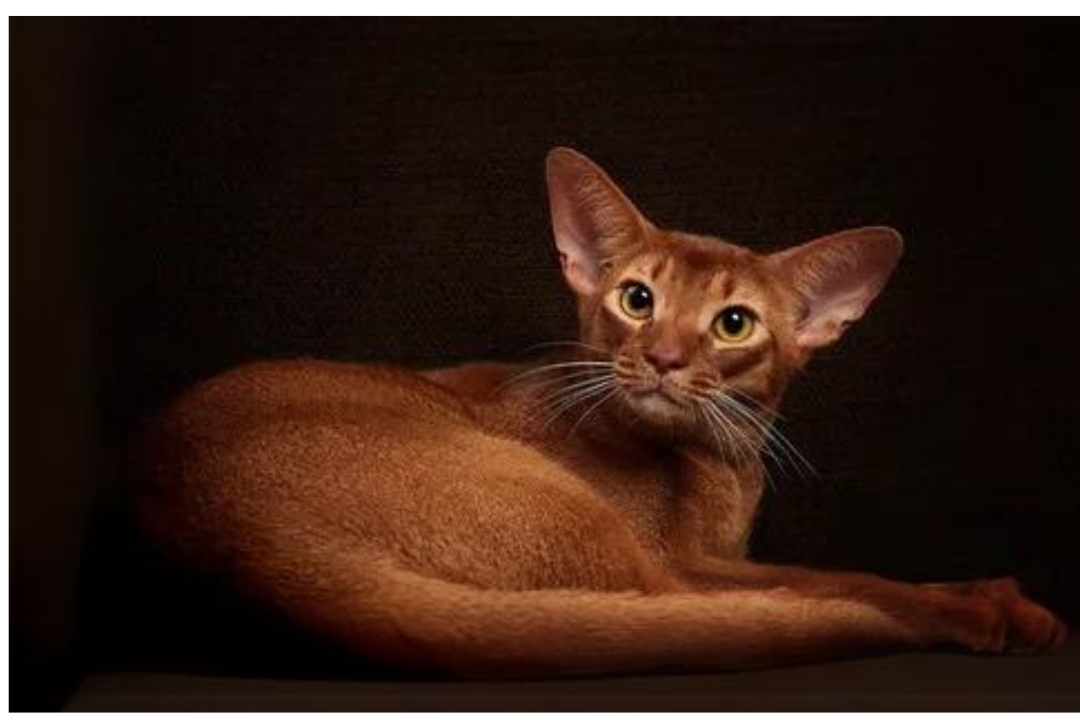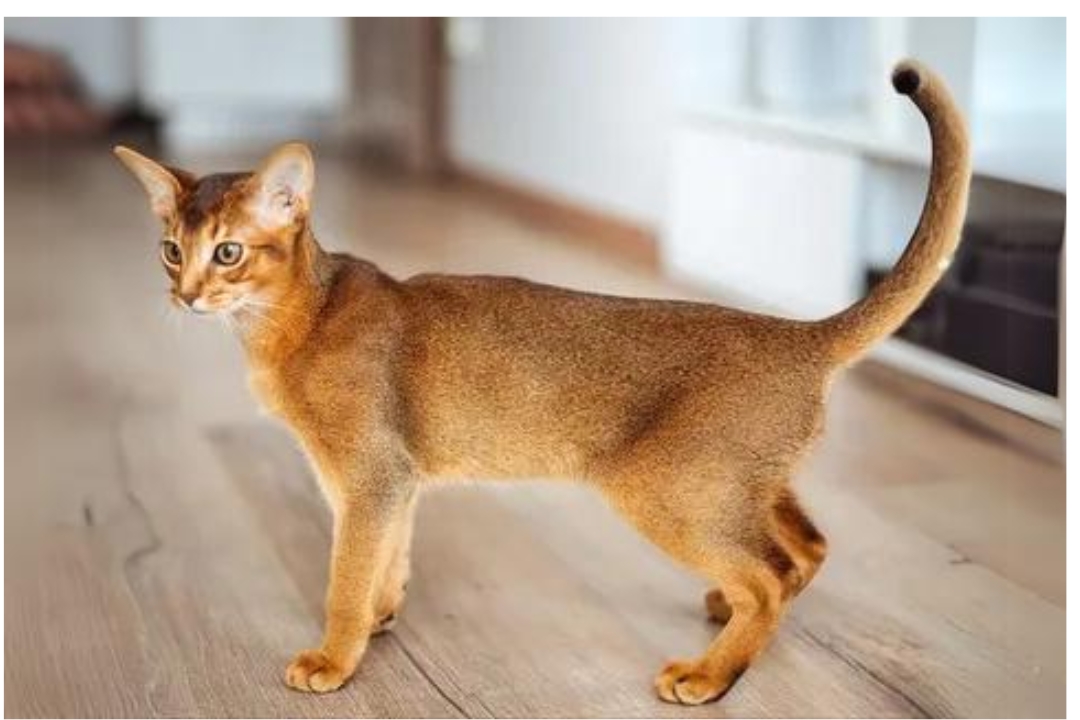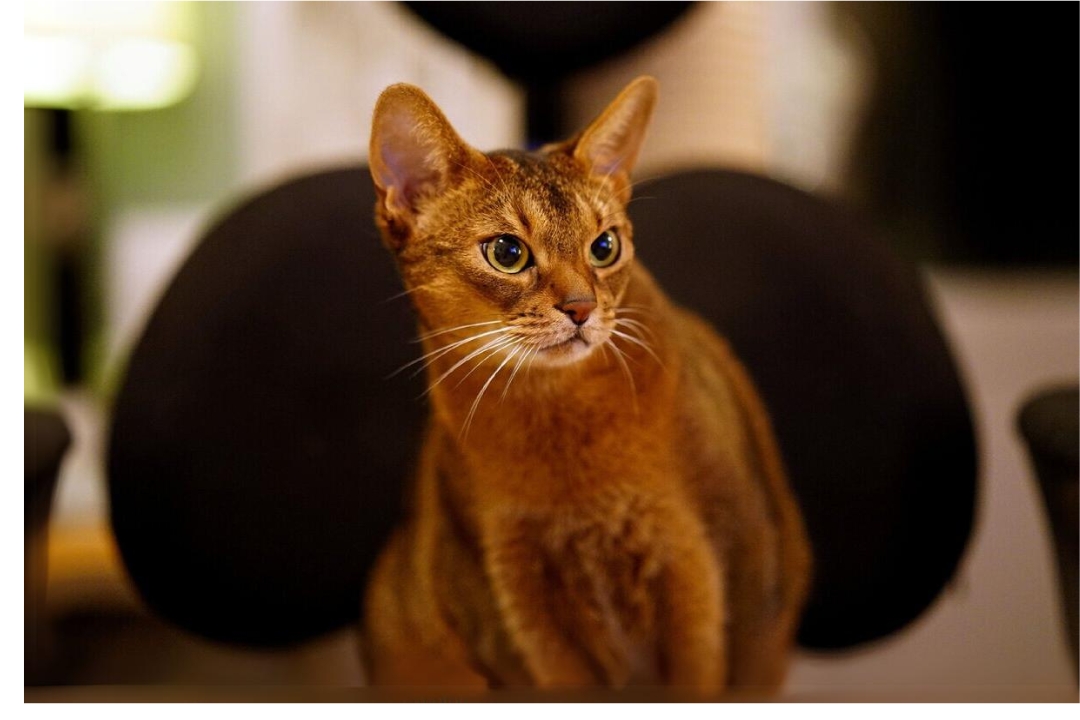The Abyssinian Cat: A Comprehensive Guide 17
History and Origins
The beginnings of the Abyssinian feline are fairly baffling and saturated with legend. The variety’s name proposes an association with Abyssinia, current Ethiopia, yet most proof focuses to the variety being created in Egypt. Abyssinians look similar to the felines portrayed in old Egyptian craftsmanship, with their agile bodies, almond-molded eyes, and huge ears.
The variety was first displayed in Britain in the late nineteenth 100 years, where it was said to have been brought from Abyssinia by English fighters getting back from war. Nonetheless, hereditary examinations demonstrate that the variety probably began nearer to the Indian Sea, with impacts from antiquated Egyptian felines. No matter what its actual beginning, the Abyssinian immediately acquired fame in Europe and North America for its fascinating appearance and exuberant demeanor.
Physical Characteristics
The Abyssinian is a medium-sized feline, known for its solid form and effortless, athletic stance. Key actual characteristics include:
Coat: The Abyssinian’s most unmistakable component is its short, ticked coat. Every hair is united with different tones, giving the feline a warm, sparkling appearance. The coat comes in different tones, with rosy, red, blue, and grovel being the most widely recognized.
Eyes: Abyssinians have enormous, almond-formed eyes that can be gold, green, hazel, or copper, adding to their expressive and ready look.
Ears: Their enormous, pointed ears are set wide separated, giving the Abyssinian a curious, practically wild appearance.
Body: The body is flexible and strong, with long legs and a slim tail. They are medium in size however seem bigger because of their lean and athletic form.

Personality and Temperament
Abyssinians are frequently depicted as “individuals situated” felines. They are unbelievably friendly, adoring, and lively, creating them ideal allies for the people who can give them adequate consideration and cooperation. Key parts of their demeanor include:
Dynamic and Fiery: Abyssinians are one of the most dynamic feline varieties. They love to climb, bounce, and investigate their environmental elements. Proprietors frequently find them roosted on the most elevated focuses in the house, noticing all that with strong fascination
Keen: Abyssinians are exceptionally wise and inquisitive. They appreciate puzzle toys, learning stunts, and participating in intuitive play. Their knowledge likewise implies they can in some cases be naughty, tracking down ways of opening entryways or pantries.
Friendly: While not regularly lap felines, Abyssinians are exceptionally warm and appreciate being near their people. They frequently pursue their proprietors around the house, looking for friendship and collaboration.
Care Requirements
Really focusing on an Abyssinian is moderately clear, however there are explicit contemplations to remember:
Preparing: The Abyssinian’s short coat is low-support and requires negligible prepping. Week after week brushing will assist with eliminating free hairs and keep their jacket looking smooth. They are likewise known for being meticulous custodians themselves.
Work out: Because of their high energy levels, Abyssinians need a lot of actual work. Giving climbing structures, intuitive toys, and customary recess is fundamental. They likewise appreciate open air nooks or secure spaces where they can securely investigate.
Diet: A decent, high-protein diet means quite a bit to help the Abyssinian’s dynamic way of life. Proprietors ought to talk with their veterinarian to guarantee they are giving the right nourishment to their feline’s age, weight, and movement level.
Health Considerations
Abyssinians are for the most part sound felines, however like all varieties, they can be inclined to specific hereditary circumstances. Potential medical problems include:
Periodontal Infection: Abyssinians are helpless to dental issues, so customary dental consideration, including brushing and expert cleanings, is significant.
Moderate Retinal Decay (PRA): This is a hereditary condition that can prompt visual impairment. Mindful reproducers screen for PRA, so getting an from a trustworthy source is urgent.
Renal Amyloidosis: Here amyloid, an unusual protein, is stored in the kidneys, possibly prompting kidney disappointment. Normal veterinary check-ups can assist with observing kidney wellbeing.
Patellar Luxation: A few might be inclined to patellar luxation, where the kneecap separates, causing inconvenience or weakness.
Cultural Significance and Mythology
The Abyssinian feline’s puzzling beginning has energized different fantasies and legends, further upgrading its persona. In old Egypt, felines were loved as consecrated creatures, frequently connected with the goddess Bastet, the god of home, fruitfulness, and security. The likeness between the Abyssinian and the felines portrayed in antiquated Egyptian workmanship has driven numerous to conjecture that they are immediate relatives of these venerated cats.
The variety’s outlandish appearance and great bearing have likewise made it an image of polish and secret in current culture. In writing and craftsmanship, Abyssinians are much of the time depicted as shrewd, old creatures with an association with the mysterious past. This social importance adds to their allure, causing them a number one among the people who to see the value in history, folklore, and the special job of felines in human civilization.
Behavioral Traits and Social Dynamics
Abyssinians are frequently portrayed as having a “canine like” character, a quality that separates them from numerous other feline varieties. They are exceptionally faithful and will generally serious areas of strength for shape with their proprietors, frequently following them from one space to another and welcoming them energetically when they get back. This connection isn’t simply an issue of friendship; Abyssinians really appreciate being essential for the family’s everyday exercises.
Intelligent Play: Abyssinians blossom with intuitive play. Not at all like more stationary feline varieties, they need toys that challenge them both genuinely and intellectually. Puzzle feeders, feather wands, and laser pointers are especially famous with Abyssinians. Their knowledge implies they rapidly tire of tedious games, so assortment is critical to keeping them locked in.
Correspondence: Abyssinians are known for their expressive vocalizations. They are not so clearly or garrulous as Siamese felines, but rather they really do have a scope of sounds they use to speak with their proprietors. These felines frequently “peep” or “quaver” because of their proprietors’ voices or to communicate interest.
Versatility: Regardless of their dynamic nature, are very versatile. They can flourish in different day to day environments, from clamoring families with youngsters and different pets to calmer conditions with a solitary proprietor. Notwithstanding, they truly do best in homes where they have a lot of feeling and valuable chances to investigate.

Training and Intelligence
Abyssinians are among the most teachable feline varieties. Their knowledge, joined with their energy to connect with individuals, makes them responsive to learning new deceives and orders. Uplifting feedback methods, for example, treats and recognition, function admirably with Abyssinians. They can be instructed to get, come when called, and, surprisingly, stroll on a rope.
Rope Preparing: Strolling a feline on a chain could appear to be uncommon, however frequently take to it with energy. Beginning preparation early and utilizing a well-fitting outfit is critical. Rope strolls can give genuinely necessary activity and mental feeling, particularly for indoor-just Abyssinians.
Critical thinking Abilities: Abyssinians have a talent for critical thinking. This can be both a gift and a test for proprietors. They can sort out some way to open entryways, cupboards, and even resistant to youngster locks. Furnishing them with safe riddles or food-apportioning toys can assist with directing this knowledge in sure ways.
Breeding and Genetic Considerations
Rearing Abyssinians requires cautious thoughtfulness regarding hereditary wellbeing. Mindful reproducers center around keeping up with the variety’s advantageous qualities while limiting the gamble of acquired medical problems. Potential proprietors ought to look for raisers who direct wellbeing screenings for conditions like Moderate Retinal Decay (PRA) and Renal Amyloidosis, guaranteeing that little cats are solid and have a lower hazard of fostering these issues.
Hereditary Variety: One of the difficulties in rearing is keeping up with hereditary variety. Because of their prevalence, there is a gamble of overbreeding, which can prompt a diminishing in hereditary variety and an expansion in medical conditions. Respectable raisers frequently team up globally to present new bloodlines and safeguard the variety’s wellbeing and essentialness.
Variety Varieties: While the exemplary reddish variety is the most notorious, additionally come in other striking tones like blue, cinnamon, and silver. Each variety has its own one of a kind allure, yet all offer the variety’s trademark ticked coat design. The ticking, where every hair is united with various varieties, gives the its unmistakable look.
Lifespan and Aging
Abyssinians are known for their life span, with many living great into their adolescents and some in any event, arriving at their mid twenties. Their dynamic way of life and hearty constitution add to their long life expectancy, however like all felines, they might require exceptional consideration as they age.
Senior Consideration: As age, they might dial back somewhat, yet they frequently hold their fun loving and inquisitive nature very much into their senior years. Customary veterinary check-ups become progressively vital to screen for age-related conditions like joint pain, dental issues, and kidney infection. Furnishing an agreeable climate with simple admittance to their most loved resting spots and litter box is likewise fundamental as they age.
Diet for Life span: Nourishment assumes a vital part in the life span of Abyssinians. An eating regimen wealthy in top notch protein, with the right harmony between nutrients and minerals, upholds their dynamic digestion. Proprietors might have to change their feline’s eating routine as they age, zeroing in on food sources that help joint wellbeing and kidney capability.
Abyssinians in Popular Culture
The remarkable appearance and character have made it a number one in mainstream society. They have been highlighted in movies, books, and in any event, publicizing efforts. Their colorful look and drawing in nature pursue them a characteristic decision for jobs that require a feline with presence and moxy.
In Writing: Abyssinians have showed up in different works of fiction, frequently depicted as canny and to some degree mysterious animals. Their old appearance loans them a quality of secret, making them famous as allies for wizards, investigators, and travelers in dream and secret classes.
In Media: are not as usually found in media as a few different varieties, yet when they do show up, they have an enduring impression. Their striking looks and dynamic nature make them noteworthy, whether in a TV plug or an element film.
Historical Development and Recognition
The Abyssinian feline, while saturated with the persona of antiquated Egypt, really saw its advanced turn of events and acknowledgment fundamentally in the West. In the late nineteenth and mid twentieth hundreds of years, reproducers in Britain started to refine the variety’s particular attributes, prompting the exquisite, smooth we know today.
Early Acknowledgment: The principal Abyssinian displayed was in 1871 at the Gem Royal residence in London. The feline, named “Zula,” was depicted as an extraordinary and striking creature, particular from different felines of the time. Nonetheless, taking note of that “Zula” reasonable didn’t look like the advanced Abyssinian altogether, as the variety was still during the time spent development is significant.”
Normalization: The variety standard for was slowly settled as reproducers zeroed in on refining the ticked coat, huge ears, and almond-molded eyes. By the mid twentieth hundred years, had acquired prominence in both Britain and the US, with true acknowledgment by feline vaults, for example, the Feline Fanciers’ Affiliation (CFA) in 1917.
Post-War Reproducing: The Universal Conflicts fundamentally affected many feline varieties, including the Abyssinian. Reproducers needed to modify the populace after The Second Great War, which included cautious determination to keep up with the variety’s positive attributes while guaranteeing hereditary variety. The endeavors paid off, and the ubiquity kept on developing all through the mid-twentieth 100 years.
Unique Behavioral Characteristics
Abyssinians are not simply dynamic and energetic; they have a bunch of social qualities that make them really special among feline varieties. These attributes add to their standing as perhaps of the most captivating and intelligent sidekick.
“Clownish” Conduct: Abyssinians are known for their energetic tricks, frequently depicted as “clownish.” They have a talent for transforming even the most everyday items into toys, and their interest can lead them into entertaining circumstances. Proprietors frequently tell accounts of their pursuing shadows, jumping on undetectable prey, or performing gymnastic jumps in quest for a toy.
Pack Conduct: Not at all like many felines, Abyssinians display conduct more much the same as pack creatures. They flourish in group environments and frequently foster close bonds with their human proprietors as well as different pets in the family. This can incorporate different felines, canines, or even birds and little creatures. Their friendly nature makes them not so much regional but rather more ready to share their space.
Routine Sweethearts: In spite of their dynamic and inquisitive nature, Abyssinians are predictable animals. They value schedules and frequently expect everyday exercises like taking care of, recess, or sleep time. This attribute can make them simpler to oversee concerning conduct, as they rapidly learn and adjust to the family’s musicality.

The Abyssinian’s Role in Modern Breeding
The Abyssinian fundamentally affects the advancement of other feline varieties, because of its unmistakable hereditary attributes and striking appearance.
Somali Felines: Perhaps of the most eminent variety impacted by the Abyssinian is the Somali feline. Basically a long-haired variant of the Abyssinian, the Somali offers a similar ticked cover and exuberant character however with a more extravagant, streaming coat. This breed rose up out of rearing projects where the long-haired quality was a latent characteristic.
Different Impacts: The Abyssinian’s hereditary qualities have additionally added to the advancement of different varieties, especially as far as coat example and design. The Abyssinian’s remarkable ticking design has been brought into other rearing lines, impacting the presence of breeds like the Ocicat, which consolidates the jacket qualities with a wild, spotted appearance.
Outcrossing for Wellbeing: To keep up with the wellbeing and essentialness of the Abyssinian breed, reproducers at times use outcrossing methodologies, acquainting qualities from different varieties with lessen the gamble of hereditary illnesses. This training guarantees that the Abyssinian populace remains hereditarily assorted and less defenseless to acquired conditions.
Health Management and Lifelong Care
While Abyssinians are for the most part strong and sound felines, their dynamic way of life and long life expectancy require mindful consideration all through their lives.
Dental Consideration: One of the most well-known wellbeing worries for is dental infection, especially periodontal sickness. Ordinary brushing and dental check-ups are fundamental to forestall plaque develop and keep up with oral wellbeing. A few might profit from dental bites or unique eating regimens intended to decrease tartar.
Checking Weight: Given their dynamic nature, Abyssinians normally keep a sound load with legitimate eating regimen and exercise. Notwithstanding, similar to any feline, they can be inclined to weight gain if overloaded or under-worked out. Observing their weight and changing their eating routine case by case is significant, particularly as they age and their digestion eases back.
Mental Feeling: Mental excitement is pretty much as vital as actual activity for Abyssinians. Without satisfactory mental commitment, they can become exhausted and may foster social issues like unnecessary vocalization, horrendous way of behaving, or over-prepping. Puzzle toys, instructional courses, and customary recess are exceedingly significant for their psychological prosperity.
Improving with age: As enter their senior years, they might expect acclimations to their consideration schedule. Ordinary veterinary visits become significantly more vital to get any early indications old enough related conditions. Joint enhancements, milder sheet material, and inclines or moves toward assist them with getting to their number one spots can assist them with remaining agreeable as they age.
The Abyssinian’s Impact on Human Lives
Abyssinians, with their one of a kind mix of knowledge, fondness, and movement, significantly affect the existences of the individuals who invite them into their homes.
Holding Through Communication: Abyssinians are known for making profound, significant securities with their proprietors. Their intelligent nature implies that they frequently become more like relatives than pets. They are sensitive to their proprietor’s temperaments and schedules, frequently giving solace during difficult stretches and happiness during blissful minutes.
Abyssinians and Kids: Abyssinians are by and large great with youngsters, particularly the individuals who comprehend how to associate with felines. Their lively nature makes them incredible allies for youngsters, for however long recess is regulated to guarantee that both the feline and kid are protected. They are patient and lenient yet in addition know when to leave assuming they need some alone time.
Improving Lives Through Play: The perky and dynamic nature of implies that they give a ton of pleasure and diversion into a family. Their tricks, joined with their adoration for collaboration, make them a steady wellspring of tomfoolery. Whether it’s playing get, pursuing a laser pointer, or just investigating their current circumstance, keep life intriguing.

Conclusion
The Abyssinian feline is a variety that spellbinds with its magnificence, insight, and dynamic character. Their rich history, joined with their drawing in conduct, causes them a #1 among feline darlings who to see the value in a sidekick that is however intelligent as it very well might be free. Whether you’re attracted to their old roots, their perky jokes, or their tender nature, the is a variety that offers interminable euphoria and friendship.
For anybody thinking about bringing an into their house, be ready for a relationship that goes past the regular feline proprietor dynamic. Abyssinians are valid accomplices throughout everyday life, partaking in your day to day exercises, testing your psyche, and giving unqualified love. With legitimate consideration, consideration, and understanding, can be a deep rooted companion and a wellspring of interminable interest.
Abyssinian Cat FAQs
- What makes the Abyssinian cat unique compared to other breeds?
Abyssinians are unique due to their distinctive ticked coat, which gives them a warm, shimmering appearance. They are also known for their active, playful nature and their high intelligence. Abyssinians often form strong bonds with their owners, exhibit dog-like loyalty, and enjoy being involved in daily activities.
- How much exercise does an Abyssinian cat need?
Abyssinians are very energetic and require plenty of physical and mental stimulation. They need regular interactive play sessions and enjoy activities like climbing, chasing, and puzzle toys. Providing them with cat trees, scratching posts, and safe outdoor enclosures can help meet their exercise needs.
- Are Abyssinians good with children and other pets?
Yes, Abyssinians are generally good with children and other pets, including dogs. They are social cats that enjoy companionship and playtime. However, interactions with young children should be supervised to ensure that both the cat and child are safe and comfortable.
- Do Abyssinians require a lot of grooming?
Abyssinians have short coats that require minimal grooming. Weekly brushing is usually sufficient to remove loose hairs and keep their coat in good condition. They are also known for being clean and fastidious groomers, so they generally maintain their own appearance well.
- What is the lifespan of an Abyssinian cat?
Abyssinians typically have a long lifespan, often living between 12 to 15 years, and sometimes even into their 20s with proper care. Regular veterinary check-ups, a healthy diet, and plenty of exercise can contribute to their longevity.
- Are Abyssinians prone to any specific health issues?
While generally healthy, Abyssinians can be prone to certain genetic conditions such as Progressive Retinal Atrophy (PRA), Renal Amyloidosis, and periodontal disease. Regular veterinary care and genetic screening from reputable breeders can help manage these risks.
- How intelligent are cats?
Abyssinians are among the most intelligent cat breeds. They are quick learners and can be trained to perform tricks, respond to commands, and even walk on a leash. Their intelligence also means they need plenty of mental stimulation to prevent boredom.
- Do Abyssinians get along well with other cats?
Abyssinians generally get along well with other cats, especially if they are introduced properly and given time to adjust. Their social and playful nature means they often enjoy the company of other cats and can form close bonds with them.
- Are Abyssinians vocal cats?
Abyssinians are moderately vocal. They tend to “chirp” or “trill” rather than meow loudly, using these sounds to communicate with their owners. While they are not as talkative as some breeds, like the Siamese, they do enjoy vocalizing their thoughts and feelings.
- What should I feed my cat?
Abyssinians thrive on a high-protein diet that supports their active lifestyle. High-quality commercial cat food that meets AAFCO guidelines for your cat’s life stage is recommended. Consult with your veterinarian to determine the best diet for your cat’s age, weight, and activity level.
- How much attention do Abyssinians need?
Abyssinians need a significant amount of attention due to their social and active nature. They enjoy interacting with their owners, playing games, and being involved in household activities. If left alone for long periods, they can become bored or lonely, so it’s important to provide them with plenty of companionship.
- Can Abyssinians be kept as indoor-only cats?
Yes, Abyssinians can be kept as indoor-only cats, but they require plenty of stimulation to stay happy and healthy. Providing them with toys, climbing structures, and safe spaces to explore indoors will help meet their needs. If possible, a secure outdoor enclosure or supervised outdoor time can also be beneficial.
- How do I know if an cat is right for me?
Abyssinians are ideal for people who want an active, intelligent, and affectionate cat that will be involved in their daily life. If you enjoy interactive play, training, and spending time with your pet, an Abyssinian might be a great fit. However, if you’re looking for a more independent or low-energy cat, another breed might be better suited to your lifestyle.
- How can I find a reputable Abyssinian breeder?
To find a reputable Abyssinian breeder, start by researching breeders through cat breed associations like the Cat Fanciers’ Association (CFA) or The International Cat Association (TICA). Look for breeders who prioritize the health and well-being of their cats, perform genetic screenings, and provide a clean and caring environment. Visiting the breeder, asking about health guarantees, and reading reviews from previous buyers can also help ensure you’re working with a reputable source.
- What is the best way to introduce an to a new home?
When bringing an into a new home, it’s important to give them time to adjust. Start by confining them to a single room with their litter box, food, water, and some toys. Gradually introduce them to the rest of the home and any other pets. Providing plenty of attention and interaction during this period will help them feel secure and settle in quickly.
